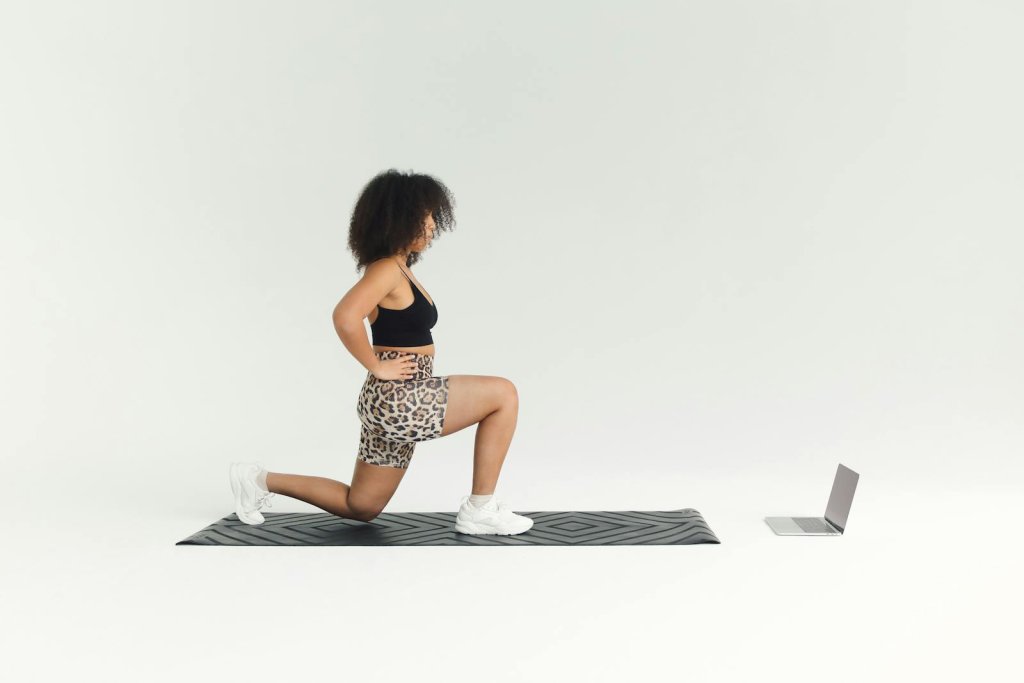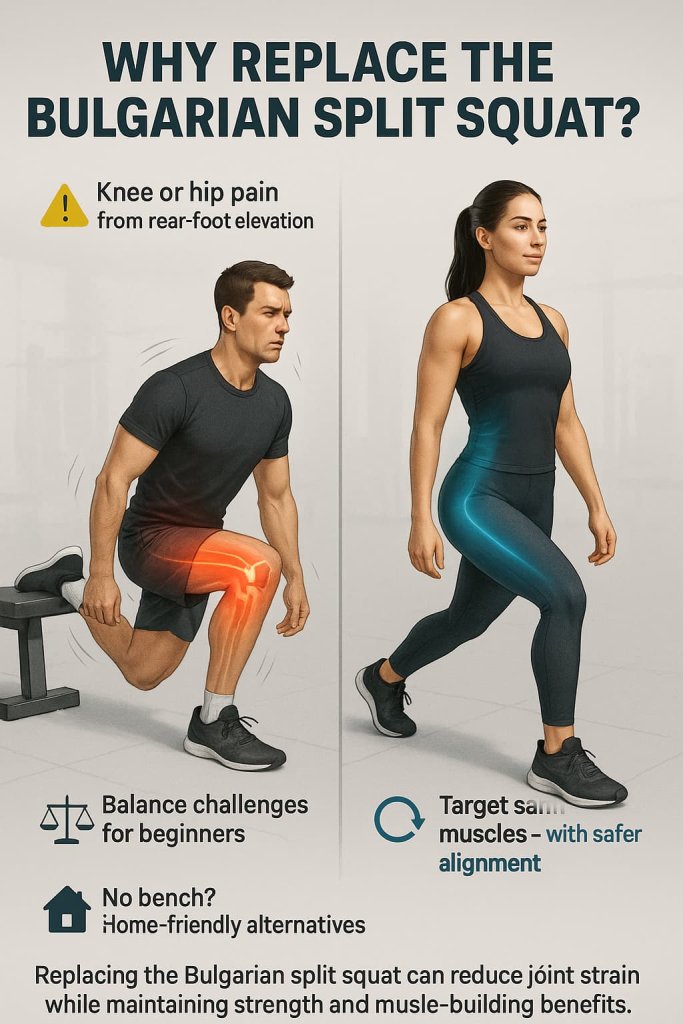The best Bulgarian split squat alternatives include lunges, step-ups, split squats, and single-leg presses — all of which build leg size, strength, and balance without requiring a bench.
The Bulgarian split squat is one of the most effective lower-body exercises, but not everyone can perform it comfortably. Whether it’s balance issues, knee discomfort, or limited equipment, there are plenty of movements that deliver the same muscle-building and stability benefits.

In this guide, you’ll discover 10 of the best Bulgarian split squat alternatives — all backed by research and strength coaching practice — so you can keep growing your quads, glutes, and hamstrings safely and effectively.
Why Replace the Bulgarian Split Squat?
The Bulgarian split squat challenges unilateral strength and balance but can be difficult for those with poor stability, limited mobility, or no bench access.

Common reasons to look for alternatives include:
- Knee or hip pain when the rear foot is elevated
- Poor balance or coordination
- Lack of available bench or stable surface
- Desire for new stimulus or different muscle emphasis
According to the Journal of Strength and Conditioning Research (2023), unilateral training variations (like lunges and step-ups) can achieve similar or even higher activation in the glutes and quads compared to elevated split squats, especially when performed through a full range of motion.
Key Muscles Targeted (Same as Bulgarian Split Squat)
- Quadriceps
- Gluteus maximus and medius
- Hamstrings
- Adductors
- Core stabilizers
10 Best Bulgarian Split Squat Alternatives
These 10 Bulgarian split squat alternatives build the same strength, balance, and muscle symmetry — without requiring a bench or advanced mobility.
Each one targets your quads, glutes, and hamstrings for powerful, joint-friendly leg development.
1. Forward Lunge
Why it works:
The forward lunge mirrors the Bulgarian split squat’s unilateral focus but adds a forward step, training balance, coordination, and eccentric control. It improves hip mobility and strengthens stabilizers by challenging your body to decelerate and push back under control — making it both a strength and functional balance exercise.
Muscles worked:
Quadriceps, glutes, hamstrings, calves, core stabilizers.
How to do it:
- Stand tall with feet hip-width apart.
- Step one foot forward and lower your back knee toward the floor until both knees form 90° angles.
- Keep your torso upright and front knee aligned with your toes.
- Push through the front heel to return to the starting position.
Trainer Tip:
Take shorter steps for more quad focus, or slightly longer steps for more glute and hamstring engagement.
2. Reverse Lunge
Why it works:
Stepping backward reduces forward knee travel, making this lunge variation easier on the knees while keeping glute activation high. It’s ideal for building leg strength and improving hip stability without joint strain.
Muscles worked:
Glutes, hamstrings, quads, core.
How to do it:
- Begin standing with feet hip-width apart.
- Step one foot backward and lower into a lunge until both knees reach about 90°.
- Drive through the front heel to return to standing.
- Repeat on the other leg.
Trainer Tip:
Keep your weight centered on your front heel — this ensures your glutes stay engaged and knees remain protected.
3. Static Split Squat
Why it works:
This grounded version of the Bulgarian split squat removes balance challenges from the rear-leg elevation, allowing you to focus purely on strength, form, and muscle engagement.
Muscles worked:
Quads, glutes, hamstrings, core stabilizers.
How to do it:
- Take a split stance with one foot forward and the other slightly back.
- Lower your back knee straight toward the floor, keeping your front heel grounded.
- Drive through the front leg to return to standing.
Trainer Tip:
Keep your shoulders stacked over your hips — avoid leaning forward to maintain even muscle activation and joint safety.
4. Step-Up
Why it works:
The step-up closely mimics the upward drive of a split squat, emphasizing glute and quad power while improving single-leg balance and coordination.
Muscles worked:
Glutes, quadriceps, hamstrings, calves.
How to do it:
- Stand in front of a stable box or bench.
- Step one foot up and press through your heel to bring your body to standing.
- Lower slowly and repeat with the other leg.
Trainer Tip:
Don’t push off the trailing leg — focus on using your leading leg to lift your entire body for maximum strength benefit.
5. Walking Lunge
Why it works:
This dynamic movement adds constant tension and balance work through every step, improving leg endurance, stability, and coordination — ideal for athletes and functional training.
Muscles worked:
Quads, glutes, hamstrings, calves, core.
How to do it:
- Step forward into a lunge.
- Push off the front heel and step the back leg forward into the next lunge.
- Continue alternating legs in a walking motion.
Trainer Tip:
Keep your steps consistent and torso upright. For extra intensity, hold dumbbells at your sides.
6. Front Foot Elevated Split Squat
Why it works:
Raising the front foot slightly increases knee flexion, shifting greater tension to the quads and improving depth without overloading the hips or lower back.
Muscles worked:
Quads, glutes, adductors.
How to do it:
- Place your front foot on a small weight plate or low platform (2–4 inches).
- Step your rear foot back into a split stance.
- Lower your back knee under control, keeping the front heel grounded.
- Drive through your front heel to return.
Trainer Tip:
Focus on smooth, slow eccentrics to maximize quad activation.
7. Smith Machine Split Squat
Why it works:
By stabilizing the bar path, the Smith machine allows heavier loads with less balance demand — making it excellent for hypertrophy and controlled tension.
Muscles worked:
Quads, glutes, hamstrings.
How to do it:
- Position one foot forward and the other back in a split stance under the Smith bar.
- Lower until your back knee nearly touches the floor.
- Press through your front heel to return to standing.
Trainer Tip:
Keep your front knee aligned with your toes and focus on a slow, controlled tempo for better muscle recruitment.
8. Single-Leg Leg Press
Why it works:
A stable machine-based alternative that removes balance challenges while allowing heavy unilateral loading — ideal for isolation and strength progression.
Muscles worked:
Quads, glutes, hamstrings.
How to do it:
- Sit in the leg press machine with one foot centered on the platform.
- Lower the platform until your knee reaches about 90°.
- Push through your heel to return to the top without locking out.
Trainer Tip:
Maintain constant tension — avoid full lockout to keep pressure on the target leg.
9. Curtsy Lunge
Why it works:
Incorporates rotational movement, targeting the gluteus medius and adductors — essential for hip stability and balance in multidirectional sports.
Muscles worked:
Gluteus medius, quads, adductors, hamstrings.
How to do it:
- Stand tall and step one leg diagonally behind the other.
- Lower your body until your front thigh is nearly parallel to the floor.
- Push through the front heel to rise back up.
Trainer Tip:
Keep hips facing forward — avoid twisting your torso to prevent knee strain.
10. Goblet Squat
Why it works:
An upright, full-range squat that strengthens the entire lower body while improving posture and mobility. It’s beginner-friendly yet effective for building powerful quads and glutes.
Muscles worked:
Quads, glutes, adductors, core.
How to do it:
- Hold a dumbbell or kettlebell close to your chest with both hands.
- Lower into a squat, keeping your heels planted and chest lifted.
- Push through your heels to return to standing.
Trainer Tip:
At the bottom, keep elbows inside your knees — it improves depth and helps maintain proper alignment.
Safety & Precautions
- Warm up your hips, knees, and ankles before training.
- Focus on control — avoid bouncing or collapsing at the bottom.
- Start with bodyweight before adding resistance.
- Maintain neutral spine alignment to prevent strain.
- If you have knee or hip injuries, consult a certified trainer or physical therapist.
FAQs
1. What’s the best substitute for Bulgarian split squats at home?
The static split squat or reverse lunge requires no bench and minimal space.
2. Are Bulgarian split squat alternatives still effective for glute growth?
Yes — exercises like step-ups and reverse lunges have comparable glute activation.
3. How often should I train single-leg exercises?
Two to three times per week is optimal for strength and balance improvements.
4. Can I use machines instead of free weights?
Absolutely — the Smith machine split squat or single-leg press are excellent controlled options.
5. Should I do these alternatives before or after squats?
Perform them after compound lifts like squats for targeted hypertrophy and balance training.
6. What’s the best variation for beginners?
Start with static split squats or reverse lunges for stability before advancing to step-ups or front-foot elevated versions.
7. How deep should I go in these exercises?
Aim for 90° knee bend or as deep as comfortable without losing form or balance.
Conclusion
You don’t need a bench to build powerful, balanced legs. These 10 Bulgarian split squat alternatives offer everything you need — strength, muscle growth, mobility, and balance — with options for every fitness level and equipment setup.
Start with bodyweight versions, master your form, and progress to loaded variations to keep challenging your lower body safely and effectively.
References
- Bulgarian Split Squat vs. Traditional Squat (Review) — biomechanics, joint angles, EMG patterns across split-squat variants. Sports (2021).
Read the full review - RFESS (Bulgarian) vs. Hip Thrust: Hip & Knee Extensor Contributions — clarifies where the Bulgarian loads the chain across depths. Journal of Strength & Conditioning Research (2021).
PubMed - Split Squat vs. Forward Lunge: Step Length & Stability Effects — informs selection and cueing between static split squats and lunges. BMC Sports Science, Medicine and Rehabilitation (2023).
Open access - Patellofemoral Loading: Forward vs. Backward (Reverse) Lunge — forward lunge shows higher PFJ force/loading rate; supports knee-friendly reverse lunge guidance. Gait & Posture (2021).
PubMed - Knee & Hip Joint Moments: Reverse Lunge vs. Single-Leg Squat — reverse lunge shows favorable knee kinetics; programming for sensitive knees. Journal of Athletic Training (2015).
Open access - Glute Max EMG Across Common Lifts (Step-Ups rank high) — validates step-ups as a top glute-focused alternative. International Journal of Sports Physical Therapy (2020).
Full text - Unilateral vs. Bilateral Training (Meta-analysis) — unilateral work improves unilateral strength/jump/balance; underpins single-leg emphasis. Biology of Sport (2023).
Open access - Unilateral vs. Bilateral Resistance Training (Systematic Review & Meta-analysis) — confirms unilateral methods for unilateral outcomes; complements #7. Frontiers in Physiology (2021).
Full text
